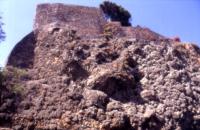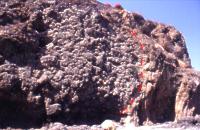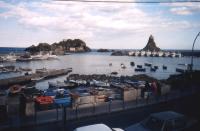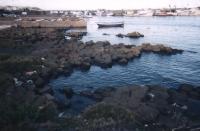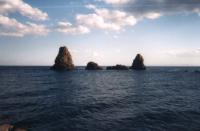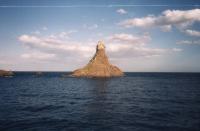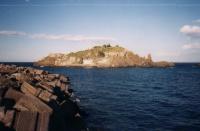|
|||||||||||||||||
|
Geological evolution of Mount Etna
|
|||||||||||||||||
|
The following is based largely on two recent publications (see below) and has additional information from other sources which are indicated in the text. Gillot, P.Y., Kieffer, G. and Romano,
R. (1994) The evolution of Mount Etna in the light of potassium-argon
dating. Acta Vulcanologica, 5: 81-87. Prelude: Volcanism on the Hyblean Plateau Volcanism in eastern Sicily has occurred episodically since the middle Triassic, producing voluminous mafic (that is, silica-poor) lavas and clastic (fragmental) material, much of which was erupted and deposited below the sea level. The sites of volcanic activity were located in the southeastern part of Sicily, on the Hyblean Plateau (Monti Iblei), an area uplifted tectonically during the late Pliocene and Pleistocene. The most recent major cycle of volcanism in that sector lasted from the late Miocene (Tortonian) until the early Pleistocene (~1.4 Ma) and showed a migration of eruptive centers northwards. A notable feature of this volcanism was the brief duration of each eruptive event (maybe a few years to several centuries) and the lack of major volcanic edifices, all activity occurring from regional fissures controlled by the predominant tectonic trends (WSW-ENE). The products of the most recent episodes of Hyblean volcanism lie buried under hundreds of meters of late Pleistocene and recent alluvial sediments, and their precise age is not known, but it appears that there is a more or less continuous series of volcanics becoming progressively younger towards north. On the northern margin of the Catania Plain, an area of tectonic subsidence covered with fluvial deposits between Etna and the northern Hyblean Plateau margin, volcanic rocks outcrop again, but these are considerably younger than those of the Hyblean Plateau and are generally considered the earliest manifestations of volcanism in the Etnean area. First phase: "pre-Etnean" Volcanic
activity in the Etnean area began around 0.5 Ma (million years) ago.
This initial activity, the first of four main phases during the evolution
of Etna, was very similar in character to the latest Hyblean volcanism,
and its products were mainly submarine lavas and volcaniclastics of
tholeiitic composition (for more info of this type of basaltic rock,
see "The
life stages of Hawaiian volcanoes" from Volcano World,
and the geochemistry
page about Loihi volcano, Hawaii). The famous outcrops of
Acicastello, a town some 10 km north of Catania, and nearby locations
contain pillow lavas and hyaloclastites produced by this early activity.
It is generally believed that this phase of volcanism took place in
a vast marine gulf, extending over part of the area occupied by the
present Etna, which was subsequently filled by sediments intermixed
with volcanics helped by regional tectonic uplift. Second phase: "Ancient Etna" The second phase of volcanism at Etna, called "Ancient Etna", began with more localized eruptions (such as the Paternò eruptive center, SSW of Etna, dated at 168 plus/minus 10 ka=thousand years). Several authors (Romano, 1982, Romano et al., 1979) have named these eruptive centers the "Ancient alkali eruptive centers". It is assumed that a first large stratovolcano (the Calanna eruptive center; 100-130 ka) was built at a later stage of this phase. The erupted magmas were alkali basalts and hawaiites. Third phase: "Trifoglietto II" The third phase of Etnean volcanism is generally named "Trifoglietto II" and was characterized by the building of several overlapping stratovolcanoes: Trifoglietto II, a large stratovolcano consisting of lavas and pyroclastics, Vavalaci, and Cuvigghiuni being the most important of these volcanoes. Among the products of these volcanoes, most were alkaline differentiated magmas (trachyandesites), leading to a much more explosive volcanism than that of the earlier phases. The growth of the stratovolcanoes was at times interrupted, and in most cases terminated, by caldera collapse. The oldest dated products of this phase are about 80 ka old while another datation higher up in the stratigraphy yielded an age of about 63 ka. Fourth phase: "Mongibello" The
fourth phase saw the growth of the Mongibello stratovolcano whose evolution
is divided into three stages, Ancient, Recent and Modern Mongibello.
Its oldest dated products are about 35 ka old. During this phase, Etna
produced the most differentiated (trachytic) magmas of its entire history;
this occurred about 15-16 ka ago and led to the eruption of ignimbrites
(the deposits of pyroclastic flows) which are visible in outcrops near
the town of Biancavilla, on Etna's SW flank. Ash from these highly explosive
eruptions was distributed over a wide area in the Mediterranean and
has recently been identified in lacustrine (related to a lake) deposits
in the crater lakes of the Colli Albani near Rome (Calanchi et al.,
1996), about 800 km NNW of Etna! This event was probably accompanied
by the collapse of a caldera named Ellittico, a depression about 3 km
in diameter which has been filled by more recent eruptive products and
partially eaten away by more recent caldera collapse. After this period
of trachytic magmatism, the compositions of the erupted products became
more mafic (that is, poor in silica but with higher Mg and Fe contents),
and the activity became predominantly effusive.
|
|||||||||||||||||
|
Copyright © Boris Behncke, "Italy's Volcanoes: The Cradle of Volcanology" |
|||||||||||||||||
|
Page
set up on 11 May 1999, last modified on 16 February 2000
|
|||||||||||||||||

